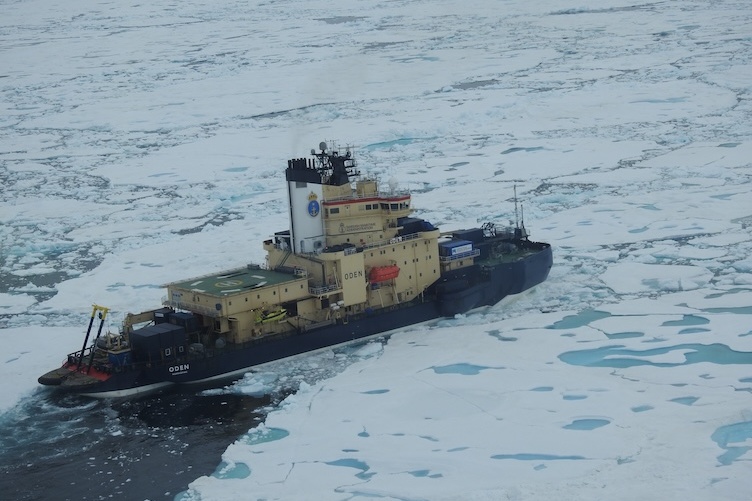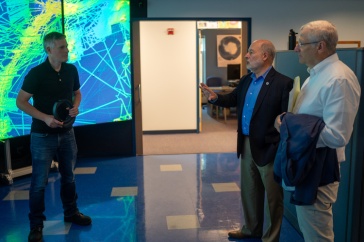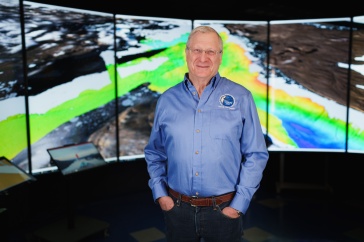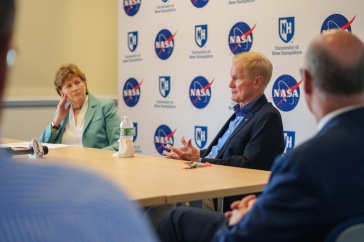
Photo courtesy of Larry Mayer.
Scientists from the University of New Hampshire have made history as part of a team aboard the Swedish icebreaker ODEN, which is the first vessel to navigate the remote and icy Victoria Fjord in North Greenland and collect data in this uncharted area. The information they are gathering will provide insight into the rapid melting of the Greenland Ice Sheet and enhance scientists’ understanding of the effects of climate change on global sea-level rise.
“No other ship has been to this part of the Arctic before,” said Larry Mayer, a professor and director of the Center for Coastal and Ocean Mapping (CCOM) at the University of New Hampshire. “In getting here we have encountered some of the most remarkable scenery and lighting I have ever seen while collecting data that will inevitably have significant scientific value .”
"No other ship has been to this part of the Arctic before. In getting here we have encountered some of the most remarkable scenery and lighting I have ever seen while collecting data that will inevitably have significant scientific value."
The UNH team is part of the GEOEO North of Greenland 2024 Expedition, organized by the Swedish Polar Research Secretariat, which is working to learn more about the melting of the Greenland ice sheet — the largest contributor to global sea level rise. The team encountered heavy ice in the Lincoln Sea and was blocked from heading too far into the fjord because of icebergs but the ODEN managed to travel far enough into the fjord to allow them to achieve their scientific objectives.
“The glacier teams have flown by helos to the end of the fjord to see how the glacier transitions into the ocean and it has been amazing — nothing like the other fjords we studied (Petermann and Sherard Osborn) where there was a sharp transition at the end of an ice shelf,” said Mayer. “Here it is a huge mixture of giant cracks and crevices and massive pieces of ice all broken up — there is no simple ice front here.”
The UNH researchers are using a small robotic Seafloor Systems Echoboat vehicle equipped with a Norbit multibeam sonar to map the seafloor and record the shape of glaciers and icebergs below the surface. The Echoboat allows scientists to map in areas that are too shallow or dangerous for a larger vessel to approach. The three-member team works around the clock, sleeping in shifts, mapping the deep ocean floor using a large multibeam echosounder mounted on the Icebreaker ODEN and deploying the robotic vehicle to map hard to navigate areas like the underside of large icebergs. The information they collect will provide important data that can be used in scientific modeling that could help more accurately predict the processes effecting the melting of glaciers that are associated with global sea level rise.

“So much is unknown about the Victoria Fjord, including how deep it is, how deep the glaciers are on either side and the depth of the underwater ridges at the entrance of the fjord,” said Mayer.
A fjord is a long, deep and narrow sea inlet with an opening out to the ocean. In previous research, the same Swedish and American teams found that the underwater ridges in the fjords can play a major role in controlling the melting of the glacier. Warm water from the Atlantic Ocean is able to enter fjords with very deep ridges, while those with shallower ridges are better at keeping the warm water out, which helps prevent the ice from melting.
The expedition is comprised of over 40 researchers from 10 universities and six countries.
Other members of the UNH team include Brian Calder, a research professor and associate director of CCOM and affiliate assistant research professor Elizabeth Weidner ’23G. You can learn more about the day-to-day operations in the expedition blog.
Four members of the GEOEO North of Greenland 2024, including two from UNH, are members of the Explorers Club and this expedition has been selected as an Explorers Club Flag (#35) and Rolex Expedition. The Explorers Club is a world-renowned professional organization with the goal of promoting scientific exploration and field study. Flags have been carried on every continent, to both poles, to outer space and to the depths of the oceans.
The mapping of this remote ocean frontier also contributes to the Nippon Foundation-GEBCO-Seabed 2030 project, with the goal of having all oceans mapped by 2030.
Funding for the expedition is provided by the Swedish Research Council VR, Formas (a Swedish research council for sustainable development), the European Research Council, the Knut and Alice Wallenberg Foundation and the U.S. National Oceanographic and Atmospheric Agency’s Office of Ocean Exploration.
-
Written By:
Robbin Ray ’82 | UNH Marketing | robbin.ray@unh.edu | 603-862-4864


















































